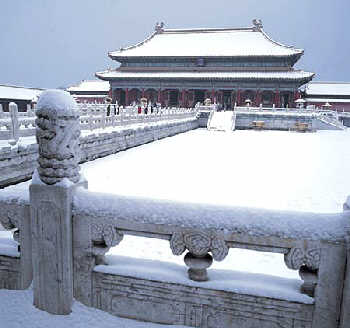
The second section begins after entering Wumen. The atmosphere of the Taihemen Square is greatly relaxed. Beginning from Damingmen, after the atmosphere of the three palatial squares has become intensified layer by layer, it changes over to the transition between the Taihedian Square. The volume of the structure is not large, with the jinshui River meandering through it. Five stone bridges are erected over the river, creating a lively atmosphere.
Taihedian Square, in a square shape, encircled by corridors on four sides and covering about 40,000 square meters, is the heart of the entire palatial zone and even the entire city of Beijing. The big hall is located in the northern part of the square, standing above a three-layered white stone platform. The front side is 6O meters long, with an area of 2,380 square meters, and is about 37 meters high from the ground of the square to the ridge of the h3ll. It is the largest existing hall in China. In the middle of the southern courtyard is Taihemen, with two small doors on the left and right sides, ending with corner towers on the further left and right. The left and right corridors each have a garret, which is the horizontal axis of the square.
The characteristic content of the Taihedian (Hall of Supreme Harmony) Square is very deep and rich. The pyramid-type, three-dimensional composition formed by the huge volume and stratified platform of the big hall, as well as the golden glazed tiles, red walls and white terrace make it appear to be very solemn and stable, playing up the imperial power At the same time, implicated in solemnity and seriousness are peace, tranquility and grandioseness, which contains, social unity and coordination and maintain the harmony and stability of popular feelings. Here it is both necessary to show the emperor's dignity and demonstrate his "benevolence and deep bountifulness". It is also necessary to express the spirit of this great empire ruled by the emperor through grandioseness and solemnity Through the use of bricks, tiles, wood and stones of emotionless color and structures, and their components essentially without the function of indicating and describing things, artists abstractedly, and yet clearly, show off the complicated and fine ideology. Its achievements are the pride of Chinese architectural art.
All squares in the area from Damingmen to T3ihedian are paved with bricks and stones without growing flowers, grass and trees, so as to strengthen the serious keynote effect.
Behind Taihedian are the two halls of Zhonghe (Hall of Complete Harmony) and Baohedian (Hall of Preserving Harmony), serving as a foil of T3ihedian. The three halls are sitting on an l-shaped white stone platform. Dayuetai Platform stands Out in the front edge of the word "I". If the position is seen in a line with south at the top and north at the bottom, the platform is shaped like the word "+ ". In line with the Chinese five-element concept of gold, wood, water, fire and earth, the latter sits in the middle and is the most respectable.
Houqin, which uses the horizontal Qianqingmen (Gate of Heavenly Purity Square as the lead, is a long courtyard. The front Qianqinggong(Palace of Heavenly Purity) is the largest, and the rear Kunninggong(Palace of Earthly Tranquility) is smaller. Later, a square plane jiaotaidian(Hall of Heavenly and Earthly Intercourse) were added between the Qianqing and Kunning palaces. The three halls are all located on a one-storied high I-shaped stone stylobate. The scale of Houqin is much smaller than the Qianchao, but the design and architectural form are similar to Qianchao, making it seem like the reappearance of the symphonic theme.

Copyright ©1999-2011 Chinanews.com. All rights reserved.
Reproduction in whole or in part without permission is prohibited.